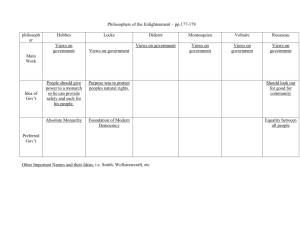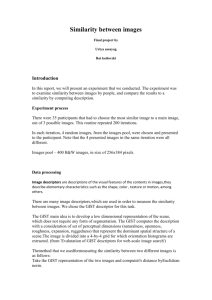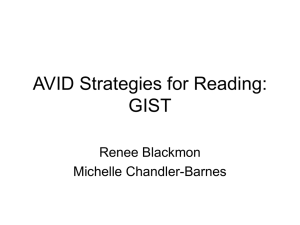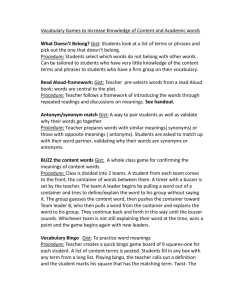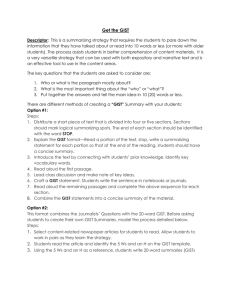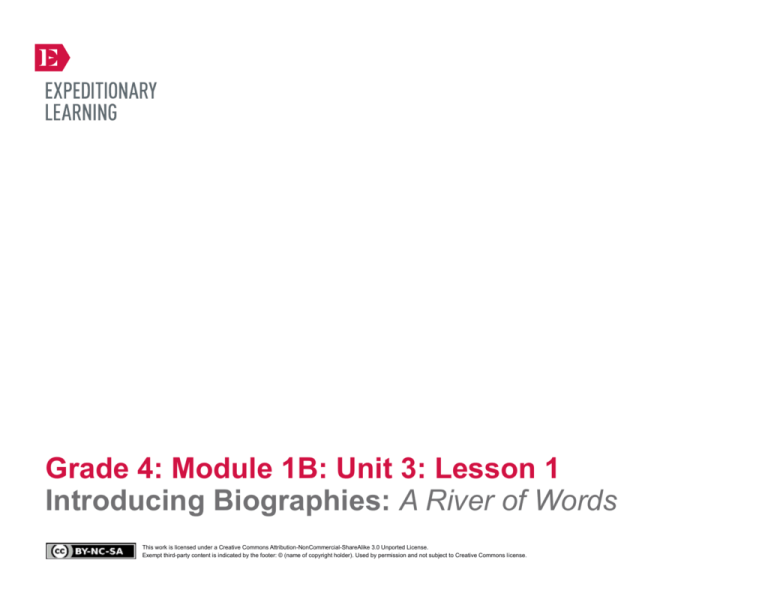
Grade 4: Module 1B: Unit 3: Lesson 1
Introducing Biographies: A River of Words
This work is licensed under a Creative Commons Attribution-NonCommercial-ShareAlike 3.0 Unported License.
Exempt third-party content is indicated by the footer: © (name of copyright holder). Used by permission and not subject to Creative Commons license.
GRADE 4: MODULE 1B: UNIT 3: LESSON 1
Introducing Biographies:
A River of Words
Long-Term Targets Addressed (Based on NYSP12 ELA CCLS)
I can explain what a text says using specific details from the text. (RI.4.1)
I can make inferences using specific details from the text. (RI.4.1)
I can determine the main idea using specific details from the text. (RI.4.2)
I can summarize informational or persuasive text. (RI.4.2)
Supporting Learning Targets
Ongoing Assessment
• I can identify the text features of A River of Words.
• Gist recording form
• I can define the word “biography.”
• Exit ticket
• I can determine the gist of A River of Words.
Copyright © 2013 by Expeditionary Learning, New York, NY. All Rights Reserved.
NYS Common Core ELA Curriculum • G4:M1B:U3:L1 • June 2014 •
1
GRADE 4: MODULE 1B: UNIT 3: LESSON 1
Introducing Biographies:
A River of Words
Agenda
Teaching Notes
1. Opening
• In the opening of this lesson, students review the guiding question: What inspires writers to write
poetry? They are re-introduced to this question by rereading “The Red Wheelbarrow” by William Carlos
Williams, rereading Jack’s response in Love That Dog, and discussing what inspired Jack’s response.
A. Engaging the Reader (10 minutes)
B. Reviewing Learning Targets (5 minutes)
2. Work Time
A. Text Walk: A River of Words (15 minutes)
B. Read-aloud and Determining the Gist (20 minutes)
3. Closing and Assessment
A. Revisiting the Guiding Question: What Inspired
William Carlos Williams? (10 minutes)
4. Homework
A. On a new page in the “My Reflections” section of
your poetry journal, reflect on the following
question: What has inspired you as a writer?
• Students then read a biography about William Carlos Williams: A River of Words. The Work Time
portion of this lesson thus bridges the students’ previous reading—the novel and poetry—to a new genre
of text on which they will focus during the first half of this unit: biography. Since only the teacher has a
copy of A River of Words, students do not read the text closely on their own. Instead, they listen as it is
read aloud and determine the gist. Students then circle back to the guiding question: What inspires
writers to write poetry? This launches students into a deeper study of biographies and the challenge of
inferring what has inspired their selected poet (whose poems they began reading during Unit 2).
• In Lessons 2 and 3, students will closely read the Author’s Note from A River of Words (provided in
Lesson 2 supporting materials) to learn more about Williams and the features of biographies, as well as
about how to refine the “things close readers do.” Then, in Lessons 3 and 4, students read a short
biography about their selected poet in preparation for writing the essay component of their performance
task.
• Teachers must find a way to display the pages of the one copy of A River of Words so all students can
clearly see the text features during the Text Walk, and read the words and see the illustrations when
asked to determine the gist. Consider the best way to display the pages: perhaps on a document camera,
or inviting students to gather in a whole-group area of the classroom.
• To support students in determining the gist, the text has been broken into parts that are outlined on the
Gist recording form (for teacher reference). The book itself has no page numbers, so it may help to go
through and use sticky notes or flags to mark each transition between sections. Note that on the Gist
recording form, students are only expected to determine the gist of each section of A River of Words.
Later, when students read of the Author’s Note in this book, they will learn to determine the main idea
of informational text (through a close reading of the text).
Copyright © 2013 by Expeditionary Learning, New York, NY. All Rights Reserved.
NYS Common Core ELA Curriculum • G4:M1B:U3:L1 • June 2014 •
2
GRADE 4: MODULE 1B: UNIT 3: LESSON 1
Introducing Biographies:
A River of Words
Agenda
Teaching Notes (continued)
• In Units 1 and 2 students worked in small groups for reading Love That Dog and various poems. In the
next three lessons, students will work with a partner while reading about William Carlos Williams.
These partnerships should be strategic. Place students together based on their needs, preferably with
struggling readers and proficient readers together.
• In advance:
– Prepare: William Carlos Williams anchor chart (a blank piece of chart paper with the title “William
Carlos Williams” at the top).
– Find a separate time of the day to allow students to browse and select a book for independent reading
during this unit. Students will begin reading from this text for this lesson’s homework. In Unit 2,
students were allowed to continue reading from Unit recommended texts if they chose. But now in
Unit 3, students will be reading informational text and biographies; so be sure they select a new
independent reading book from the Unit 3 recommended text list as early in this unit as is feasible.
– Reinforce organizational routines for students. If you used folders in Units 1 and 2 to organize
student materials, be sure these folders are organized and ready for new materials. If you did not use
folders in Units 1 and 2, consider using them for Unit 3; students need a place to keep their texts,
note-catchers, and graphic organizers for this unit. Students will need their reader’s notebooks,
poetry journals, Love That Dog text, and poems from Units 1 and 2. These materials may be kept
inside or alongside this folder.
– Post: Learning targets and the Guiding Questions anchor chart.
Copyright © 2013 by Expeditionary Learning, New York, NY. All Rights Reserved.
NYS Common Core ELA Curriculum • G4:M1B:U3:L1 • June 2014 •
3
GRADE 4: MODULE 1B: UNIT 3: LESSON 1
Introducing Biographies:
A River of Words
Lesson Vocabulary
Materials
text features, biography, gist;
autobiography, synopsis, dedicate
• Guiding Questions anchor chart (from Unit 1, Lesson 1)
• Love That Dog (book; one per student and one to display and read aloud)
• A River of Words (book; one for teacher read-aloud)
• Document camera
• Close Readers Do These Things anchor chart (begun in Unit 1, Lesson 2)
• Gist recording form (one per student)
• Gist recording form (for teacher reference)
• William Carlos Williams anchor chart (new; teacher-created)
• Poetry journals (students’ own; from Units 1 and 2)
Copyright © 2013 by Expeditionary Learning, New York, NY. All Rights Reserved.
NYS Common Core ELA Curriculum • G4:M1B:U3:L1 • June 2014 •
4
GRADE 4: MODULE 1B: UNIT 3: LESSON 1
Introducing Biographies:
A River of Words
Opening
Meeting Students’ Needs
A. Engaging the Reader (10 minutes)
• Place students with their reading partners. Tell them that during the next few lessons, they will be working in pairs as
readers.
• Because students will be familiar
with both of these poems, consider
choosing two strong readers to read
each aloud to the whole group
rather than reading them yourself.
• Remind students of the second guiding question for the module on the Guiding Questions anchor chart: What inspires
writers to write poetry? Tell them that they will think about this question throughout this unit.
• Ask students to get out their copies of the text Love That Dog and tell them that you would like to revisit what inspired
Jack to write his first poem.
• Tell students to turn to page 1 of Love That Dog. Read pages 1–5 aloud as students read silently in their heads.
• Ask students to take 1–2 minutes to discuss this question with their partner:
• To engage all students in the
reading process, you could also
encourage them to whisper-read the
poems in pairs rather than reading
them aloud to the whole group.
* “How do you think Jack was inspired to write his first poem about the blue car? What evidence in the text supports your
thinking?”
• Refocus students and invite volunteers to share their responses whole group. Listen for them to suggest that Jack may have
been inspired by reading William Carlos Williams’s poem “The Red Wheelbarrow” because his poem about the blue car had
very similar characteristics.
• Read “The Red Wheelbarrow” aloud as students follow along.
• Then ask students:
* “What do you think inspired William Carlos Williams to write his poem ‘The Red Wheelbarrow’?”
• Call on a few volunteers to share their thoughts; it’s fine if students don’t have a solid response or theory. Point out that
other than the content of the poem, students currently don’t have much that helps them infer what inspired Williams. Tell
them that in this unit, they will learn more about the poets they have selected and what may have inspired them as writers.
Copyright © 2013 by Expeditionary Learning, New York, NY. All Rights Reserved.
NYS Common Core ELA Curriculum • G4:M1B:U3:L1 • June 2014 •
5
GRADE 4: MODULE 1B: UNIT 3: LESSON 1
Introducing Biographies:
A River of Words
Opening (continued)
Meeting Students’ Needs
B. Reviewing Learning Targets (5 minutes)
• Focus students’ attention on the learning targets:
• Research indicates that cold calling
improves student engagement and
critical thinking. Prepare students
for this strategy by discussing the
purpose, giving appropriate think
time, and indicating that this
strategy will be used before students
are asked questions.
* “I can identify the text features of A River of Words.”
* “I can define the word ‘biography.’”
* “I can determine the gist of A River of Words.”
• Review with students the importance of learning targets—to help them know what they are expected to learn and do during a
lesson. Tell them that at the end of the lesson, they will share how they moved toward the learning targets.
• Read aloud the first learning target and underline the words text features. Ask students to briefly discuss with their partner:
* “What do you already know about text features?”
• Invite volunteers to share what they discussed whole group. Listen for students to explain that text features are things like
titles, table of contents, diagrams, charts, photographs with captions, and bulleted lists.
• Next, ask students to chorally read aloud the second learning target with you and underline the word biography. Once again,
ask them to quickly discuss with their partner what they think this word means.
• Cold call students to share what they discussed whole group. If students don’t know what a biography is, invite a student to
look it up in a dictionary and read the definition aloud for the class. Point out to students that the word biography consists
of two parts, bio meaning life and graph meaning write.
• Careful attention to learning targets
throughout a lesson engages,
supports, and holds students
accountable for their learning.
Consider revisiting learning targets
throughout the lesson so students
can connect their learning with the
activity they are working on.
• Invite students to read the third learning target with you. Underline the word gist. Ask students to briefly review gist with
their elbow partner.
• Invite volunteers to share their responses whole group. Listen for students to explain that the gist is their initial
understanding of what the text is mostly about. Remind them that the gist is a preliminary pass at a text, and is a particularly
useful early step when trying to make sense of a complex text. Getting the gist is one of the “things close readers do.”
Copyright © 2013 by Expeditionary Learning, New York, NY. All Rights Reserved.
NYS Common Core ELA Curriculum • G4:M1B:U3:L1 • June 2014 •
6
GRADE 4: MODULE 1B: UNIT 3: LESSON 1
Introducing Biographies:
A River of Words
Meeting Students’ Needs
Work Time
A. Text Walk: A River of Words (15 minutes)
• Show students the front and back cover of A River of Words. Select a student to read aloud the writing on the cover.
• Ask them to take 1 or 2 minutes to discuss with their partner:
* “What do you think the book is going to be about? Why do you think that?”
• Refocus students and invite volunteers to share their responses whole group. There are no right or wrong answers, but
because students have already read poems by William Carlos Williams, they should be able to explain that the book is about
the poet.
• Point out that this text is a biography. Review the meaning of this academic vocabulary with students. Ask:
* Who can remember from our learning targets what a biography is?
• Call on a volunteer to review the meaning of this word (an informational text about someone’s life).
• At this stage, you might also distinguish between biographies and autobiographies (the story of someone’s life written by
that person himself/herself). Point out that the root auto in the word autobiography means self. Give students the following
example, if William Carlos Williams had written this book about his life, it would be an autobiography. Point out that A
River of Words is written by Jen Bryant, and therefore it is a biography about Williams.
• Show students the inside front covers. If you have a dustcover on your book, read the words on the flap inside the front of
the book aloud. If possible, display this on a document camera so students can read along silently in their heads.
• Ask students to discuss with their partner:
* “What does this piece of writing tell us?”
• Cold call students to share their responses. Listen for them to explain that this tells the reader a little bit about William
Carlos Williams and gives us an idea of what the book is about. Tell students that this is often called the synopsis.
• Point out the rest of the writing on the inside front cover. Ask students to identify what it is. Students should recognize this
as some of William Carlos Williams’s poems.
• Show them the inside back cover and again ask students to identify the writing. Listen for students to recognize the writing
as some more of William Carlos Williams’s poems.
• If you have a dustcover on your book, read the words on the back inside flap of the book aloud for the group. If possible,
display this on a document camera so students can read along silently in their heads.
Copyright © 2013 by Expeditionary Learning, New York, NY. All Rights Reserved.
NYS Common Core ELA Curriculum • G4:M1B:U3:L1 • June 2014 •
7
GRADE 4: MODULE 1B: UNIT 3: LESSON 1
Introducing Biographies:
A River of Words
Meeting Students’ Needs
Work Time (continued)
• Ask students to discuss with their partner:
* “What does this piece of writing tell us?”
• Select volunteers to share their responses whole group. Listen for students to explain that it gives us information about the
author and illustrator of the book.
• Flick through the first five or six pages of the book with the students, but don’t read any of it. Ask students to discuss with
their partner:
* “What do you see?”
• Cold call students to share their answers whole group. Listen for students to explain that they see a title page with
illustrations and all of the other pages contain writing with illustrations.
• Turn to the timeline at the back of the book. Invite students to spend a few minutes looking at the pages and ask them:
* “What is this and how do you think it might be useful for the reader?”
• Select volunteers to share their responses. Listen for students to explain that it is a timeline of both the events in William
Carlos Williams’s life and important world events. It is useful for the reader because they can see when the most important
things happened in his life and what was going on in the world at the time.
• Turn to the Author’s Note and the Illustrator’s Note. Invite a student to read the titles. Explain that sometimes in a book, an
author and illustrator may write things they would like the reader to know about the book. For example, if a book is fiction,
but based on a real event, the author may explain that in the Author’s Note.
• Turn to the final two pages. Invite a student to read the “Further Reading” title. Explain that the author may have referred to
these books listed to help her write the story of William Carlos Williams, and if a reader is really interested in learning more
about him, they know where to look next.
• Point out that the final page explains to whom the author has dedicated the book. Briefly explain that to dedicate means to
recognize someone special by making a special gift of your work, like dedicating a song to your mother on Mother’s Day.
• Tell students that this first exploration of these text features, and the closer reading of these features in later lessons, will
help them to understand this rich text more deeply. Explain that text features are generally helpful to readers in better
understanding a text and that they will use this strategy often throughout the year.
Copyright © 2013 by Expeditionary Learning, New York, NY. All Rights Reserved.
NYS Common Core ELA Curriculum • G4:M1B:U3:L1 • June 2014 •
8
GRADE 4: MODULE 1B: UNIT 3: LESSON 1
Introducing Biographies:
A River of Words
Meeting Students’ Needs
Work Time (continued)
• Focus students on the Close Readers Do These Things anchor chart. Add the following to the bottom of the chart:
– Use text features to better understand the text: illustrations, synopsis, author’s notes, timelines.
Note: Additional text features can be listed as examples on the anchor chart as students encounter them throughout the year.
B. Read-aloud and Determining the Gist (20 minutes)
• Tell students that now that they have explored the book through their Text Walk, they will hear the whole text read aloud.
(Be sure that students can see the text as you read aloud so that they can read along and improve their fluency skills.) Read A
River of Words once through without stopping. Slowly flip through some pages of the text and point out the illustrations.
Remind them to pay close attention to these illustrations, as they will help them better understand the text.
• Display and distribute the Gist recording form. Invite students to read silently in their heads as you read the headings of
the columns. Remind students that the gist is a reader’s first impression of what the text is mostly about.
• Explain to students that you are going to read A River of Words aloud to them again and stop at strategic points so they can
write the gist of what you have just read.
• Read aloud the text again. Stop at the first place suggested on the Gist recording form (for teacher reference). Ask
students to discuss with their partner:
* “What was this section of the text mostly about?”
• Invite volunteers to share their responses. On the displayed Gist recording form, model how to record the gist (see Gist
recording form (for teacher reference) for an example response).
• Invite students to record the gist of this part of the book on first box on their recording form.
• Encouraging students to discuss
before they write can ensure that all
students have something to write
about and can provide them with
the confidence to do so.
• Consider allowing students who
require additional support in
writing to record key words and
phrases for the gist rather than
writing in complete sentences.
• To further support ELLs or other
struggling readers, consider giving a
sentence starter for the final
question on the Gist recording form:
“This book is a biography
because________.”
• Continue reading the book, stopping at the strategic places suggested on the Gist recording form. Give students time to
discuss the gist, share with the whole group, and record the gist in the correct place on their form. You do not need to model
filling out the form each time.
• Once students have written the gist of the final part of the text, invite students to discuss with their partner to synthesize
their learning about William Carlos Williams:
* “What do you now know about William Carlos Williams? What are some key facts you would share with someone who
didn’t know anything about him?”
Copyright © 2013 by Expeditionary Learning, New York, NY. All Rights Reserved.
NYS Common Core ELA Curriculum • G4:M1B:U3:L1 • June 2014 •
9
GRADE 4: MODULE 1B: UNIT 3: LESSON 1
Introducing Biographies:
A River of Words
Meeting Students’ Needs
Work Time (continued)
• Select volunteers to share their responses. Record student ideas as bullet points on the William Carlos Williams anchor
chart. Refer to A River of Words when students give responses that are not accurate.
• Afterwards, read the final question on the recording form (“How does this text fit the definition of a biography?”) aloud to
the class. If necessary, review the definition of a biography. Then ask students to write a response to this question
independently.
• Collect students’ Gist recording forms for a formative assessment of their ability to determine the gist of informational text
during a read-aloud and their initial understanding of this genre of informational text.
Copyright © 2013 by Expeditionary Learning, New York, NY. All Rights Reserved.
NYS Common Core ELA Curriculum • G4:M1B:U3:L1 • June 2014 •
10
GRADE 4: MODULE 1B: UNIT 3: LESSON 1
Introducing Biographies:
A River of Words
Closing and Assessment
Meeting Students’ Needs
A. Revisiting the Guiding Question: What Inspired William Carlos Williams? (10 minutes)
• Reread the guiding question: “What inspires writers to write poetry?” Tell students that now that they have learned more
about William Carlos Williams’s life, if will be easier to infer what inspired him to write poetry.
• For students who may need more
support, consider providing a
sentence starter for the reflection on
the guiding question. For example,
“William Carlos Williams was
inspired by ordinary things such as
__________.”
• Ask students to get out their poetry journals and turn to a fresh page in the “My Reflections” section. Ask them to respond
to the following prompt:
* “After reading a biography of William Carlos Williams, what could you infer about what inspired him as a writer?”
• Give students a few minutes to respond in writing.
• Partner students up to share their responses. After they have shared, ask for a few volunteers to share whole group. Listen
for students to suggest the following and go back to the text to point out evidence that support their responses. (See Part 2 of
the text indicated on the Gist recording form (for teacher reference)):
– William Carlos Williams was inspired to write poems because of his teacher. Evidence from text: “But when Mr. Abbott
read poetry to Willie’s English class, Willie did not feel hurried.”
– William Carlos Williams was inspired to write poems from hearing the poems of famous English writers. Evidence from
text: “At first he imitated the famous English writers he had learned about in school.”
– William Carlos Williams was inspired to write poems from the things he saw everyday, like wheelbarrows. Evidence from
the text: “I want to write about ordinary things—plums, wheelbarrows, and weeds …”
• Distribute the Homework: What Has Inspired You? handout. Read the question on the form for students:
* “In Unit 2, you wrote your own poems. What has inspired you as a writer?”
• Tell students that, for homework, their task is to record their answers to this question on their handout.
Meeting Students’ Needs
Homework
• On a new page in the “My Reflections” section of your poetry journal, reflect on the following question: What has inspired
you as a writer?
Copyright © 2013 by Expeditionary Learning, New York, NY. All Rights Reserved.
NYS Common Core ELA Curriculum • G4:M1B:U3:L1 • June 2014 •
11
Grade 4: Module 1B: Unit 3: Lesson 1
Supporting Materials
This work is licensed under a Creative Commons Attribution-NonCommercial-ShareAlike 3.0 Unported License.
Exempt third-party content is indicated by the footer: © (name of copyright holder). Used by permission and not subject to Creative Commons license.
GRADE 4: MODULE 1B: UNIT 3: LESSON 1
Gist Recording Form
Name:
Date:
Part
Gist (what the text is mostly about)
Part 1
Part 2
Part 3
Part 4
How does this text
fit the definition of
a biography? Give
an example from
the text.
Copyright © 2013 by Expeditionary Learning, New York, NY. All Rights Reserved.
NYS Common Core ELA Curriculum • G4:M1B:U3:L1 • June 2014 •
13
GRADE 4: MODULE 1B: UNIT 3: LESSON 1
Gist Recording Form
(For Teacher Reference)
Part
Gist (what the text is mostly about)
Part 1
(Up to “Sometimes, as
he listened to its perfect
tune, he fell asleep.”)
Willie grew up in Rutherford, New Jersey, and liked to spend time outside
watching everything and listening to the river.
Part 2
(Up to “… and Willie
needed to earn a
living.”)
Willie began to write poetry after enjoying listening to it at school. He
wrote a lot of poems about ordinary things and let his poems find their own
shape on the page.
Part 3
(Up to “Every
afternoon, he returned
to his office where more
patients waited.”)
Willie went to study medicine and after graduating returned home to set up
his own medical practice.
Part 4
(To the end of the
book.)
Even though he was a doctor, Willie continued to enjoy writing poems.
How does this text fit
the definition of a
biography? Give an
example from the text.
Possible Answer (examples from the text may vary): This book is a
biography because it is a story about the life of poet William Carlos
Williams. It tells about how he was inspired to write poetry and became a
doctor too.
Copyright © 2013 by Expeditionary Learning, New York, NY. All Rights Reserved.
NYS Common Core ELA Curriculum • G4:M1B:U3:L1 • June 2014 •
14

